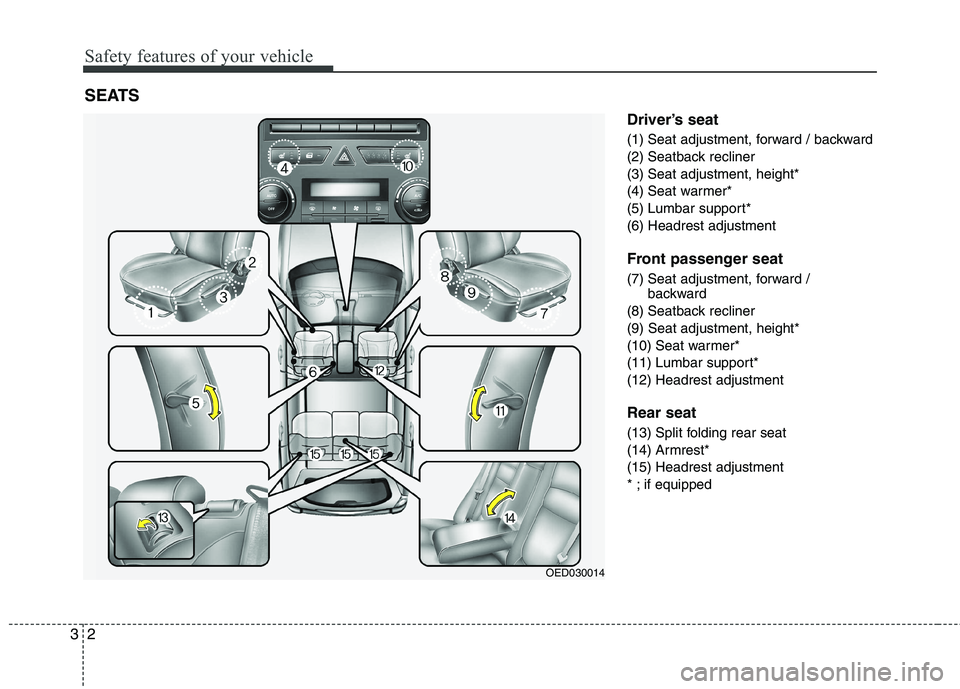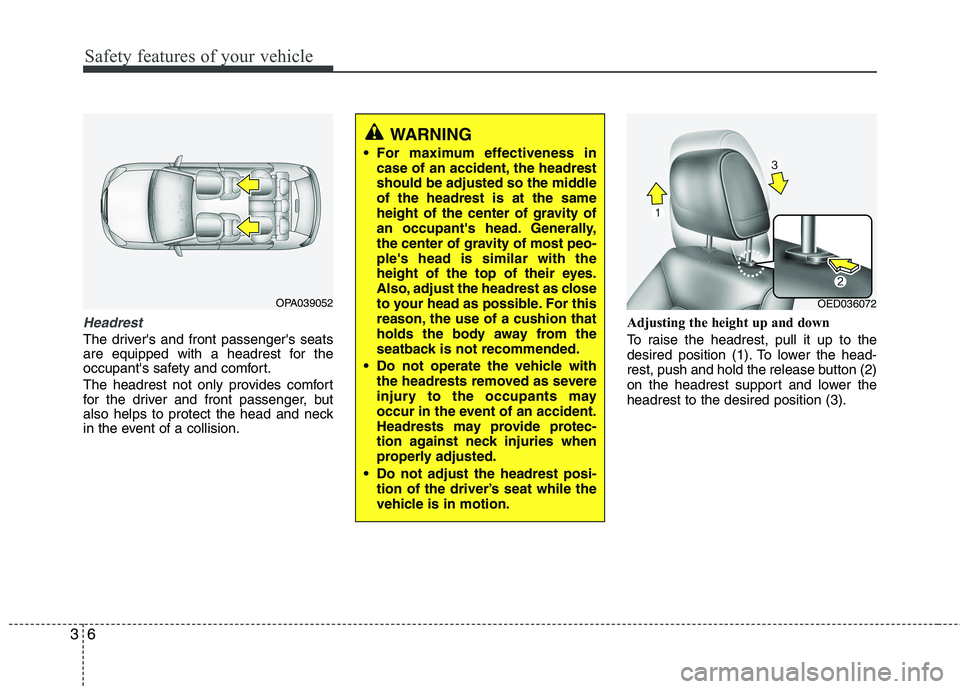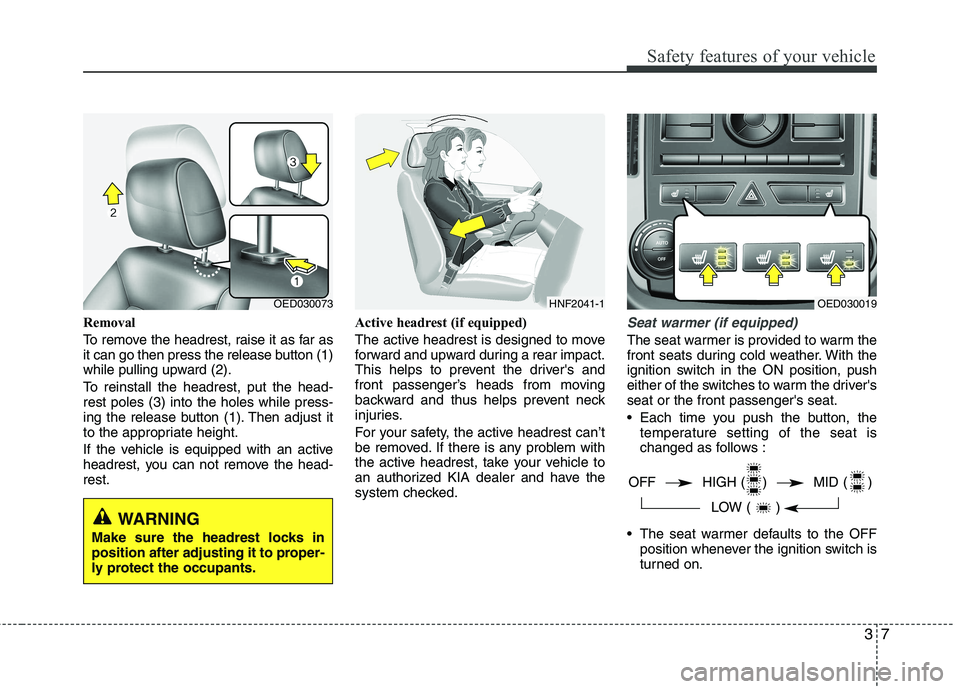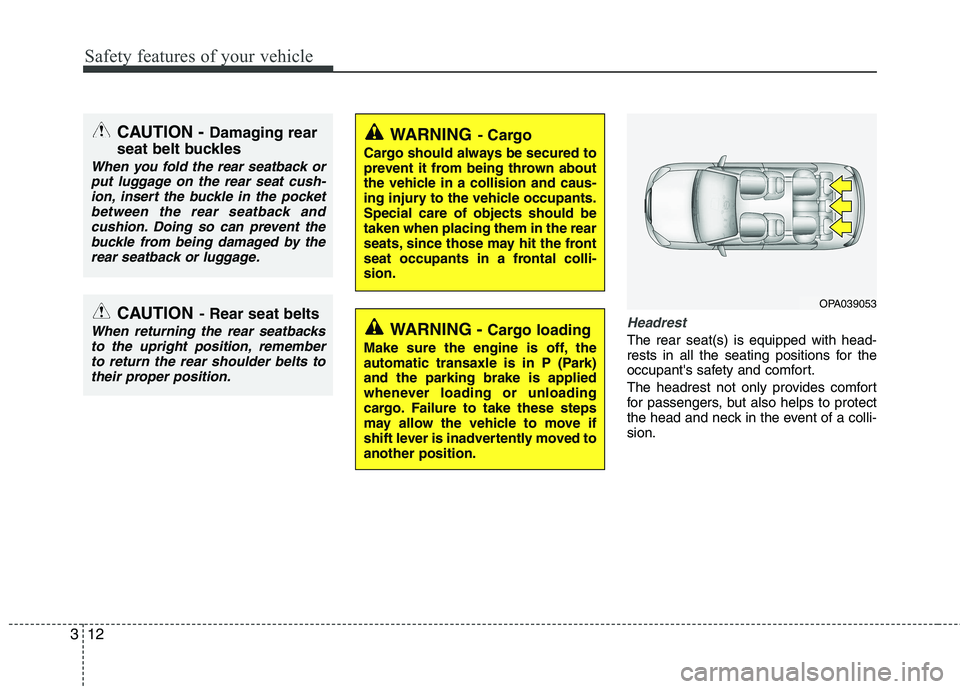headrest KIA CEED 2010 Owners Manual
[x] Cancel search | Manufacturer: KIA, Model Year: 2010, Model line: CEED, Model: KIA CEED 2010Pages: 442, PDF Size: 28.25 MB
Page 15 of 442

Safety features of your vehicle
2
3
Driver’s seat
(1) Seat adjustment, forward / backward
(2) Seatback recliner
(3) Seat adjustment, height*
(4) Seat warmer*
(5) Lumbar support*
(6) Headrest adjustment
Front passenger seat
(7) Seat adjustment, forward /
backward
(8) Seatback recliner (9) Seat adjustment, height*
(10) Seat warmer*
(11) Lumbar support*
(12) Headrest adjustment Rear seat
(13) Split folding rear seat
(14) Armrest*
(15) Headrest adjustment
* ; if equipped
SEATS
OED030014
Page 19 of 442

Safety features of your vehicle
6
3
Headrest
The driver's and front passenger's seats
are equipped with a headrest for the
occupant's safety and comfort.
The headrest not only provides comfort
for the driver and front passenger, but
also helps to protect the head and neck
in the event of a collision. Adjusting the height up and down
To raise the headrest, pull it up to the
desired position (1). To lower the head-
rest, push and hold the release button (2)
on the headrest support and lower theheadrest to the desired position (3).
WARNING
For maximum effectiveness in case of an accident, the headrest
should be adjusted so the middleof the headrest is at the same
height of the center of gravity of
an occupant's head. Generally,
the center of gravity of most peo-ple's head is similar with the
height of the top of their eyes.
Also, adjust the headrest as close
to your head as possible. For this
reason, the use of a cushion that
holds the body away from the
seatback is not recommended.
Do not operate the vehicle with the headrests removed as severe
injury to the occupants may
occur in the event of an accident.
Headrests may provide protec-
tion against neck injuries when
properly adjusted.
Do not adjust the headrest posi- tion of the driver’s seat while the
vehicle is in motion.
OPA039052OED036072
Page 20 of 442

37
Safety features of your vehicle
Removal
To remove the headrest, raise it as far as
it can go then press the release button (1)
while pulling upward (2).
To reinstall the headrest, put the head- rest poles (3) into the holes while press-
ing the release button (1). Then adjust it
to the appropriate height.
If the vehicle is equipped with an active
headrest, you can not remove the head-rest.Active headrest (if equipped)
The active headrest is designed to move
forward and upward during a rear impact.
This helps to prevent the driver's and
front passenger’s heads from moving
backward and thus helps prevent neck
injuries.
For your safety, the active headrest can’t
be removed. If there is any problem with
the active headrest, take your vehicle to
an authorized KIA dealer and have the
system checked.Seat warmer (if equipped)
The seat warmer is provided to warm the
front seats during cold weather. With the
ignition switch in the ON position, push
either of the switches to warm the driver'sseat or the front passenger's seat.
Each time you push the button, the
temperature setting of the seat is
changed as follows :
The seat warmer defaults to the OFF position whenever the ignition switch is
turned on.
HNF2041-1
WARNING
Make sure the headrest locks in
position after adjusting it to proper-
ly protect the occupants.
OED030073OED030019
OFF HIGH ( ) MID ( )
LOW ( )
Page 23 of 442

Safety features of your vehicle
10
3
3. Lift the rear portion of the seat cush-
ion. Stand the rear seat cushion verti-
cally. 4. Remove the headrest from the rear
seatback.
5. Pull the lock release lever (red visible) and fold the rear seatback forward and
down firmly. 6. Stow the headrest by inserting the
headrest poles into the holder on thebottom of the seat cushion.
OED036028AOED036026A
OED036027A
OED036024A
OED036025A
Page 24 of 442

311
Safety features of your vehicle
7. To use the rear seat, remove the head-rest from the seat cushion.
8. Lift and push the seatback backward firmly until it clicks into place. Make
sure the seatback is locked in place
(red invisible).
9. Reposition the headrest on the seat- back and adjust it to the desired posi-tion.
10. Return the seat cushion to the origi- nal position by pushing down the rear
side of the seat cushion first. Make
sure the seat cushion is locked in
place.
11. Return the rear seat belt to the prop- er position. 3 Door
1. Lower the headrest to the lowest posi-
tion.
2. Pull the lock release lever located on the top of the seatback.
3. Fold the seatback forward and down firmly.
4. To use the rear seat, lift and push the seatback backward firmly until it clicks
into place. Make sure the seatback is
locked in place (red invisible).
5. Return the rear seat belt to the proper position.
WARNING
When you return the rear seatback to its upright position after being
folded down:
Be careful not to damage the seat
belt webbing or buckle. Do not
allow the seat belt webbing or
buckle to get caught or pinched in
the rear seat. Ensure that the seat-
back is completely locked into its
upright position by pushing on the
top of the seatback. Otherwise, in
an accident or sudden stop, the
seat could fold down and allow
cargo to enter the passenger com-
partment, which could result in
serious injury or death.
CAUTION - 3 Door rear
seat
Do not fold the rear seatback for along time.
The friction between the seatbackand seat cushion may deform the
rear seat cover.
Page 25 of 442

Safety features of your vehicle
12
3
Headrest
The rear seat(s) is equipped with head-
rests in all the seating positions for the
occupant's safety and comfort.
The headrest not only provides comfort
for passengers, but also helps to protect
the head and neck in the event of a colli-sion.WARNING - Cargo loading
Make sure the engine is off, the
automatic transaxle is in P (Park)and the parking brake is applied
whenever loading or unloading
cargo. Failure to take these steps
may allow the vehicle to move if
shift lever is inadvertently moved toanother position.
WARNING - Cargo
Cargo should always be secured to
prevent it from being thrown about
the vehicle in a collision and caus-
ing injury to the vehicle occupants.Special care of objects should betaken when placing them in the rear
seats, since those may hit the front
seat occupants in a frontal colli-sion.
CAUTION - Rear seat belts
When returning the rear seatbacks
to the upright position, rememberto return the rear shoulder belts totheir proper position.
CAUTION - Damaging rear
seat belt buckles
When you fold the rear seatback or put luggage on the rear seat cush-
ion, insert the buckle in the pocketbetween the rear seatback andcushion. Doing so can prevent the buckle from being damaged by the
rear seatback or luggage.
OPA039053
Page 26 of 442

313
Safety features of your vehicle
Adjusting the height up and down
To raise the headrest, pull it up to the
highest position (1). To lower the head-
rest, push and hold the release button (2)
on the headrest support and lower the
headrest to the lowest position (3).Removal
To remove the headrest, raise it as far as
it can go then press the release button
(1) while pulling upward (2).
To reinstall the headrest, put the head- rest poles (3) into the holes while press-
ing the release button (1). Then adjust it
to the appropriate height.
OED036030
WARNING
For maximum effectiveness in case of an accident, the headrest
should be adjusted so the middleof the headrest is at the same
height of the center of gravity of
an occupant's head. Generally,
the center of gravity of most peo-ple's head is similar with the
height of the top of their eyes.
Also adjust the headrest as close
to your head as possible. The use
of a cushion that holds the body
away from the seatback is notrecommended.
Do not operate the vehicle with the headrests removed as severe
injury to an occupant may occur
in the event of an accident.
Headrests may provide protec-
tion against severe neck injuries
when properly adjusted.
OED030031
WARNING
Make sure the headrest locks in
position after adjusting it to proper-
ly protects the occupants.
Page 44 of 442

331
Safety features of your vehicle
Securing a child restraint seat with“Tether Anchor” system (if equipped)
Child restraint hook holders are located
on the transverse trim behind the rear
seats. 1. Route the child restraint seat strap
over the seatback.
For vehicles with adjustable headrest,
route the tether strap under the head-
rest and between the headrest posts,
otherwise route the tether strap over
the top of the seatback.
2. Type A
Remove the covering shelf trim and
place it in the luggage room. Make
sure it does not move.
Type B
Open the tether anchor cover.
3. Connect the tether strap hook to the appropriate child restraint hook holder and tighten to secure the seat.
WARNING - Tether strap
Never mount more than one child restraint to a single tether or to a
single lower anchorage point. The
increased load caused by multiple
seats may cause the tethers or
anchorage points to break, causing
serious injury or death.
WARNING
A child can be seriously injured or
killed in a collision if the child
restraint is not properly anchored
to the car and the child is not prop-
erly restrained in the child restraint.
Always follow the child seat manu-
facturer’s instructions for installa-
tion and use.
OED036078
OED036095
OED037095L
Type A
Type B
Page 170 of 442

499
Features of your vehicle
Your vehicle is equipped with a barrier net.
When you load some cargoes on the rear
seat or rear cargo area, you must install
the barrier net behind front seatback or
rear seatback. It is designed to help protect the heads of
the occupants by obstructing objects fly-
ing forward in frontal collisions.
There are four hook holders on both side
of the headliner over the headrests forupper side fixation and on the floor
behind the rear seats for lower side fixa-tion.To install the barrier net
1. Insert the net upper shaft into the large
hole and then secure by sliding into
the small hole. 2. Hang the net strap hooks in the hook
holders on the floor behind the rearseat.
BARRIER NET (IF EQUIPPED)
OED037107OED037108OED037109